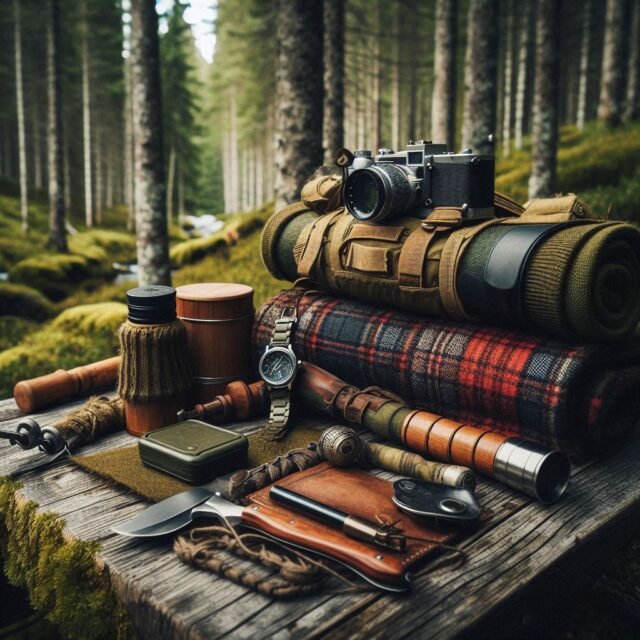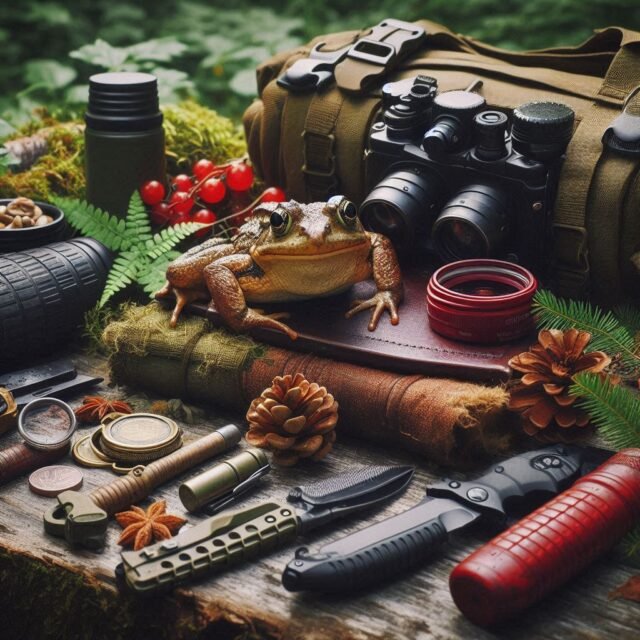The Ultimate Guide to Survival Gear for Hikers: Be Prepared for Any Adventure
Hiking is more than just a leisurely walk in nature; it’s an adventure that can challenge you physically and mentally while offering breathtaking views and unforgettable experiences.
Trust me, the great outdoors can be unpredictable, and even the most experienced hikers can find themselves in unexpected situations. That’s why having the right survival gear is crucial for every hiking trip, whether you’re a novice or a seasoned trekker.
In this trending OTL guide, we’ll explore the essential survival items every hiker should carry to ensure a safe and enjoyable adventure. We’ll jump into why each piece of gear is important, offer top product recommendations, and answer frequently asked questions to help you prepare for your next outdoor excursion.

Why Carrying Survival Gear is Non-Negotiable
Before we dive into the specifics, let’s address the fundamental question: Why is survival gear so important for hikers?
1. Unpredictable Weather: Mother Nature can be fickle. A sunny day can quickly turn into a storm, and temperatures can drop unexpectedly.
2. Potential for Injuries: Even on well-maintained trails, accidents can happen. A twisted ankle or a fall could leave you stranded.
3. Navigation Challenges: It’s surprisingly easy to lose your way, especially in unfamiliar terrain or when visibility is poor.
4. Extended Trips: Sometimes, hikes take longer than expected, and you might need to spend an unplanned night outdoors.
5. Wildlife Encounters: While rare, encounters with wildlife can occur, and being prepared can help you stay safe.
By carrying the right survival gear, you’re not just preparing for worst-case scenarios; you’re ensuring that you can handle a wide range of situations with confidence and composure.

Essential Survival Gear for Every Hiker
Let’s break down the must-have items into categories and explore why each is crucial for your hiking adventures.
1. Navigation Tools: Finding Your Way
Getting lost in the wilderness can quickly turn a pleasant hike into a dangerous situation. Here’s what you need to stay on track:
– Map and Compass: Even in the age of digital technology, these classic tools are irreplaceable. They don’t require batteries and can work in any conditions.
– GPS Device: A dedicated hiking GPS can provide precise location information and help you navigate complex trails.
– Whistle: This simple tool can be a lifesaver if you need to signal for help, as its sound carries much further than the human voice.
Top Pick: The Garmin eTrex 10 Worldwide Handheld GPS Navigator is a reliable and user-friendly option for hikers of all levels.
2. First Aid Kit: Be Your Own Medic
Accidents happen, and being able to treat injuries on the trail is crucial. A well-stocked first aid kit should include:
– Bandages and gauze for cuts and scrapes
– Antiseptic wipes and ointment to prevent infection
– Tweezers for removing splinters or ticks
– Pain relievers for headaches or minor injuries
– Any personal medications you might need
Top Pick: The Surviveware Small First Aid Kit is compact, comprehensive, and designed specifically for outdoor adventures.
3. Shelter and Warmth: Protection from the Elements
Unexpected overnight stays or sudden weather changes require gear that can keep you warm and dry:
– Emergency Blanket: Lightweight and capable of retaining body heat, these are essential for preventing hypothermia.
– Tarp or Bivy Sack: For creating a quick shelter from rain or wind.
– Fire Starters: Waterproof matches, a lighter, and firestarter sticks ensure you can start a fire in any conditions.
– Extra Clothing: Pack layers that can keep you warm and dry, including a waterproof outer layer.
Top Pick: The SOL Emergency Bivvy is ultra-light, compact, and reflects up to 90% of your body heat.
4. Hydration: The Key to Survival
Staying hydrated is critical for maintaining energy and cognitive function during your hike:
– Water Bottles or Hydration Bladder: Carry enough capacity for your planned hike, plus extra for emergencies.
– Water Purification: Tablets, filter systems, or portable UV purifiers allow you to safely drink from natural water sources.
Top Pick: The LifeStraw Personal Water Filter is a compact and effective way to ensure access to clean water in the backcountry.
5. Food and Nutrition: Fuel for Your Adventure
High-energy, lightweight foods are essential for maintaining strength and morale:
– Energy Bars: Look for options high in protein and complex carbohydrates.
– Nuts and Dried Fruits: These provide a good balance of fats, proteins, and natural sugars.
– Jerky: A lightweight source of protein that doesn’t require refrigeration.
– Dehydrated Meals: For longer trips, pack meals that only require hot water to prepare.
6. Tools and Repair Kits: Be Ready for Anything
A few versatile tools can help you tackle a wide range of challenges:
– Multi-Tool: Look for one that includes a knife, pliers, scissors, and screwdrivers.
– Duct Tape: Useful for quick repairs on gear or even as part of first aid.
– Paracord: This strong, lightweight rope has countless uses in survival situations.
Top Pick: The Leatherman Wave Plus Multitool is a high-quality, versatile option that can handle almost any task.
7. Lighting: Illuminate Your Path
Proper lighting is crucial for safety, especially if your hike extends into the evening or you need to set up camp:
– Headlamp: Keeps your hands free and is essential for night navigation or emergencies.
– Extra Batteries: Always carry spares to ensure you’re never left in the dark.
8. Communication Devices: Stay Connected
While the goal might be to disconnect, having a way to call for help in emergencies is crucial:
– Fully Charged Cell Phone: Plus a backup battery or power bank.
– Satellite Messenger: For areas without cell service, devices like SPOT X or Garmin inReach can send emergency messages.
9. Personal Protection: Guard Against Nature’s Nuisances
Protect yourself from the sun and insects to prevent discomfort and potential health issues:
– Insect Repellent: Ward off mosquitoes, ticks, and other biting insects.
– Sunscreen: Protect your skin from harmful UV rays.
– Sunglasses and Hat: Shield your eyes and face from intense sunlight.
10. Miscellaneous Items: The Final Touches
A few additional items can round out your survival kit:
– Notebook and Pencil: For leaving notes or recording important information.
– Trash Bag: Practice Leave No Trace principles by packing out all your trash.
Hiking Survival Gear FAQ
To help you further prepare for your hiking adventures, let’s address some common questions:
Q: How much water should I carry on a hike?
A: A good rule of thumb is to carry at least 1 liter of water for every two hours of hiking. However, adjust this based on the difficulty of the trail, weather conditions, and your personal needs.
Q: What should I do if I get lost?
A: Stay calm and follow the STOP principle:
– Stop: Don’t panic and avoid wandering aimlessly.
– Think: Assess your situation and resources.
– Observe: Look for landmarks or signs of trails.
– Plan: Decide on the best course of action, which often means staying put and signaling for help.
Q: How can I prevent blisters on a hike?
A: Wear properly fitting shoes, use moisture-wicking socks, and consider applying blister prevention tape to vulnerable areas before you start hiking. Break in new boots before long hikes.
Q: Is it necessary to carry a fire starter?
A: Absolutely. Fire can provide warmth, a way to purify water, cook food, and signal for help. It’s a crucial survival tool in many emergency situations.
Q: Can I rely solely on my phone for navigation?
A: While smartphones can be useful tools, they’re not reliable enough to be your only navigation method. Battery life, lack of signal, and potential damage make them unreliable in wilderness settings. Always carry a physical map and compass as backups.
Q: What type of clothing should I wear for a hike?
A: Dress in layers using moisture-wicking and quick-drying fabrics. This allows you to adjust to changing weather conditions and maintain comfort throughout your hike.
Q: How do I choose the right backpack for a hiking trip?
A: Consider the length of your trip and choose a backpack with appropriate capacity. Look for features like padded straps, multiple compartments, and compatibility with hydration systems. Most importantly, ensure it fits your body comfortably when fully loaded.

Gear Up for Safe Hiking Adventures
Being prepared with the right survival gear is not about paranoia; it’s about empowering yourself to handle whatever challenges nature might throw your way.
By carrying these essential items, you’re not just ensuring your safety; you’re also enhancing your ability to fully enjoy the beauty and serenity of the great outdoors.
Remember, the specific gear you carry may vary based on your destination, the length of your trip, and the expected conditions. Always research your planned route and check weather forecasts before setting out.
And perhaps most importantly, let someone know your hiking plans and expected return time.
Hiking is a wonderful way to connect with nature, challenge yourself, and create lasting memories. With the right preparation and essential survival gear, you can embark on your adventures with confidence, knowing you’re ready for whatever lies ahead on the trail.
So gear up, step out, and explore the wonders that await you in the great outdoors.
Happy hiking friends!





Leave a Reply